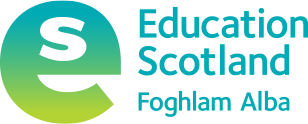Mathematics and numeracy self-evaluation framework: The self-evaluation process
Self-evaluation helps to drive improvement through a process of evidence and reflection. This includes evaluating practice against the identified themes, gathering evidence and informed collaborative decision-making.
Quality Indicators, themes and guidance from How Good is Our School? (HGIOS4) and the Quality Improvement Framework for Early Learning and Childcare, have been cross-referenced within this framework. This ensures that mathematics and numeracy self-evaluation is aligned and complementary to both national and local authority approaches.
Reflections and next steps can be mapped against the three underpinning questions:
-
How well are we doing in mathematics and numeracy?
-
How do we know?
-
What are we going to do now?
The framework supports improvement across four interdependent themes:
-
Leadership, culture, ethos and strategy
-
Curriculum learning and teaching
-
Data and assessment
-
Professional learning
The framework can be used in themed individual sections, or as a whole document, depending on the priorities and needs of the setting.
Each theme has a similar format which includes a journey grid and a series of short reflective questions to support collaborative discussion.
Sub-themes
Each theme within the framework is split into corresponding sub-themes. Within each sub-theme there is a set of reflective questions. These support discussions about strengths and help to identify areas for improvement.
The framework provides a three-point progression scale. Use the following categories to support reflection and record your progress:
-
Starting the journey: this is an area that you intend to focus on or that you plan to start working on or work on.
-
Building momentum: work in this area is underway and has moved beyond the initial implementation stages. Practice is not consistent across the setting yet. Progress is evident and some strengths are evident but there are further aspects to improve on.
-
Embedding consistent practice: we have major strengths in this area. This can be seen consistently across the setting and work in this area is sustained and impactful.
Progression scales can be used over multiple sub-themes to support identification of where to focus improvement activity.
Following improvement activity, the scales can then be revisited to identify progression and next steps.
The mathematics and numeracy framework journey grid can support settings to record and evidence their engagement with self-evaluation, identifying areas of strength and agreeing next steps for improvement.
Evidence should be gathered from a range of sources and in a variety of ways. This list is not exhaustive and there may be other types of evidence that are beneficial to the self-evaluation process. Please note that not all examples will apply to all sectors or settings.
Evidence of views and opinion
-
learner surveys
-
parent and carer surveys
-
staff surveys
-
focus groups and conversations
-
professional review and development
-
line management and staff meetings
Evidence of learning, teaching and assessment
-
observations
-
learners’ day to day work (e.g. floor books, jotters, photographs, videos)
-
learning displays
-
learner profiles
-
care plans
-
tracking and monitoring records
-
diagnostic assessments such as National Standardised Assessment, low stakes ‘pre’ assessments
-
formative assessments such as show me boards, exit passes, polls, low stakes quizzes, self-assessments
-
summative assessments such as end of unit/topic tests, localised standardised tests, national qualification exams
-
wider achievement tracking
Evidence of strategies, policies and planning approaches
-
current numeracy and mathematics strategy
-
policies or rationales (settings/ cluster/local authority)
-
progression pathways
-
knowledge and skills planners
-
setting improvement plans
Evidence gathered using wider tools and collaboration
Evidence from self-evaluation activities that provide a holistic and general improvement perspective, may also prove helpful to reference when considering curriculum specific mathematics and numeracy improvements.
Some examples of these additional tools, guidance and resources include:
How good is our school? (4th Edition)
Quality improvement framework for the early learning and childcare sectors
Scottish Attainment Challenge self-evaluation resource
STEM self-evaluation and improvement framework
Survey templates
The following templates provide as examples of the types of questions that can be asked:
Settings are encouraged to adapt the questions and wording to ensure that the information being gathered is relevant. Questions should focus on informing the ongoing self-evaluation process.
Settings should adapt the format, style and layout of these examples, to suit individual contexts.
Learner views should be gathered using a process that is appropriate to the age and needs of each individual. It may be appropriate to use the learner questions as part of focus groups instead of using the written/digital questionnaires.
You may also find it helpful to select wording from specific questions from the self-evaluation framework. This could be helpful when reflecting on previous improvement priorities and identifying progress within these areas, in addition to providing important considerations of future areas of focus.
Example e-forms, which can be duplicated and edited to suit your own context, can be found below. You will need a Microsoft Account to clone these. Microsoft word versions of the survey can be found within the downloadable version of the self-evaluation framework.
